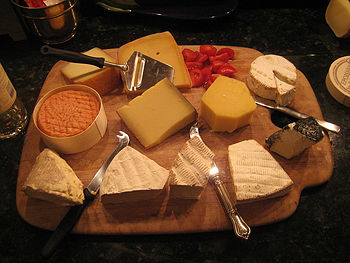Cheese
Cheese is a dairy product made from milk curd. Cheese is most commonly made from cow's milk, but is also made from the milk of other mammals such as sheep, goats, and buffalo. There are hundreds of varieties of cheese made throughout the world, all varying in texture and taste.
History
There is no definitive answer as to when and where cheese originated. The popular legend is that it was discovered by an Arab nomad who had filled his saddlebags with milk before embarking on a trip across the desert. The nomad was shocked when he opened his bags later to find his milk had separated into liquid and semisolid parts. The saddlebag was made from an animal stomach and contained the coagulating enzyme rennin. The rennin, coupled with the heat and the motion of the horse, caused the curds to separate from the whey. While there is nothing to verify this story, it is plausible that cheese was discovered in a similar manner. Most likely it was first discovered in the Middle East and Central Asia prior to 6,000 BC. Cheesemaking was later enhanced in Rome and the knowledge was spread throughout Europe with their conquering legions. The process was further developed in the Middle Ages in monasteries, creating many of the varieties of cheese we still enjoy today.
Cheesemaking
The first step in making cheese is acidification, which is the process of lowering the pH content of the milk. This is done using a bacteria culture known as a starter. The starter bacteria feeds on the lactose in the milk and as a result creates lactic acid which lowers the pH. There are two basic types of starter bacteria; mesophilic bacteria which works best at room temperature and thermophilic bacteria which is better at higher temperatures. The next step is to begin the coagulation process, which separates the milk into curds and whey by breaking down proteins. Coagulation can occur during the acidification process, however it is common practice to use enzymes to ensure the curds develop with a lower moisture content while remaining soft. These enzymes come from a substance known as rennet which is typically taken from the fourth stomach lining of calves. The primary enzyme in rennet is chymosin. Today, most chymosin used in cheese making has been genetically engineered and is no longer taken from calves.[1]
When the coagulation process is complete, the curd is heated up and cut. This is done to remove the whey completely from the curd, leaving a substance known as hard curd. Salt is added for flavoring and to prevent the growth of unwanted microbes. The curds are then pressed together with a cheese press and then shaped as desired. At this point, some cheeses such as cottage cheese are in a finished, ready to eat state. However, most cheeses are aged for a period of time and allowed to ripen. There are many types of bacteria and time frames used to ripen the cheese, each of which determine the type of cheese being made. During the ripening process, a rind is placed on the outside of the cheese. This can occur naturally or artificially.
Nutrition
Cheese contains a concentrated amount of the positive and negative benefits that are found in milk. It is a good source of protein and calcium, while being high in fat and cholesterol. Fat content varies among cheeses and is a reflection of the fat content of the milk used in making it.
Notable cheeses
- Brie—a semi-soft French cheese
- Camembert—a semi-soft French cheese
- Roquefort—a French blue cheese, "The king of cheeses and the cheese of kings."
Notes
- ↑ National Centre for Biotechnology Education, Genetically modified food case studies, chymosin. Retrieved on 2008-03-21.
